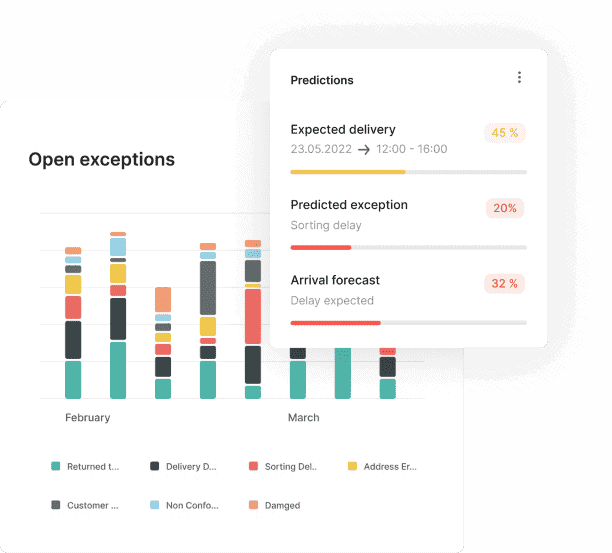Statista reports that e-commerce sales skyrocketed from $2.3 trillion in 2017 to $5.7 trillion in 2022. With the rise in competition, it’s getting harder and harder to stand out. That’s why a great customer experience is more crucial than ever. Discover how accurate shipping data can reduce customers’ anxiety and uncertainty about shipping, and set your business apart.
The state of shipping data in e-commerce
Why do businesses work hard to make sure shipping data is reliable and accurate? Because that data is what you use to reassure customers at the end of the day. And overlooking customer satisfaction could cost you dearly. According to Deloitte, customer-centric brands are 60% more profitable than companies that neglect customer experience.
However, with an increase in the number of e-commerce businesses and more players in the shipping game, ensuring accuracy in shipping data can be challenging. Still, when it comes to delivering your customers’ orders, even minor inaccuracies can significantly affect the customer experience.
What do you do when information coming from all sides eventually causes discrepancies?
Dealing with different shipment statuses
One of the challenges in managing shipping data is dealing with different shipment statuses. With thousands of varying carrier statuses available across various carriers, it’s tough to accurately follow the progress of their shipments in such a complex system. Some of the common shipment statuses you might have encountered include:
- Pending: The delivery company is preparing to process the shipment or the order is yet to be associated with a shipment.
- Pre-transit: The parcel is either still with the seller or has not yet been handed over to the carrier.
- In transit: The parcel is on its journey to the final destination.
– Potential sub statuses include: Departed; Out for delivery; Delayed - Out for delivery: The carrier is in the process of delivering the parcel to the end customer.
– Potential sub statuses include: Attempted delivery; Delivery rescheduled - Failed attempt: The carrier was unable to deliver the package.
- Waiting for delivery: Delivery was unsuccessful, and the carrier awaits further instructions for a new delivery attempt.
- Delivered: The parcel has been successfully handed over to the recipient.
– Potential sub statuses include: Delivered to a neighbor; Delivered to a safe location - Pickup ready: The parcel has reached a designated pickup point and is ready for customer collection.
- Returned: The parcel has been sent back by the customer or was refused at delivery.
- Exception: Indicates an unexpected event not covered by other statuses.
- Failure: This status is applied when there are issues processing tracking numbers or other shipment details.
Shipping data, whichever form it takes, greatly affects the customer’s delivery experience, especially during the last mile, where carrier performance is key to satisfaction.
Accurate and up-to-date data is crucial for providing customers with estimated transit times, especially when they need to be promptly notified of any shipment changes or delays.
5 key challenges in dealing with inaccurate shipping information
Unclear and inaccurate shipping information can cause a lot of problems for your business. But solving it first requires jumping over a few hurdles. Here are five major challenges that come up:
1. Different carriers use different data
You’re dependent on carriers to provide status updates to the receiver. Yet different delivery companies may have different ways of organizing and sharing shipment information. And that’s where inconsistencies come in — making it harder for you to keep track of what’s happening.
Combining this information with your existing records can be challenging, especially when dealing with various parcel statuses and details from different carriers. To make sure you get the right info, you need software that can help you standardize the data so that you can check shipping information from all the carriers you are using as efficiently as possible.
2. Real-time data is hard to retrieve
Real-time data is crucial for efficient shipping operations, which involves accurate tracking and monitoring of shipments. This data comes from carriers updating parcel statuses by scanning packages and updating their systems. However, accessing this real-time data can be tricky if your shipping partners’ systems don’t provide you with live updates.
Without real-time updates, your business may struggle to make timely decisions and accurately inform customers. To solve this, shipping analytics softwares integrates with carrier systems to offer shippers immediate information on the shipment’s location and status. No parcel statuses get left behind!
3. Missed deliveries lead to frustrations
Deliveries can be a hit-or-miss type of game. But when it comes to the latter, customers are faced with making additional customer service requests or even trying to contact the carrier to get answers. Sometimes, their packages are returned to the sender, which is not only disappointing for them but can also incur extra costs for you as the online retailer.
A lack of accurate tracking information is often the cause of these missed deliveries, leading to frustrations for both the shipper and the receiver. But avoiding bad delivery experiences is possible.
For instance, leveraging precise shipment information makes all the difference in these cases. When you can proactively communicate updates and manage expectations, the number of missed deliveries is reduced significantly.
4. Delayed packages hurt a brand’s image
When packages are late and there’s no word on what’s happening, customers get worried. If you don’t handle it right, they might start thinking your brand can’t be trusted. Remember — good delivery experiences lead to positive reviews, which 72% of consumers trust when deciding where to shop.
Yet, when there are delays, it becomes extra hard to communicate with your customers if you don’t have the right information to give them. But what if you could receive alerts about delays within minutes instead of hours? You can not only communicate delays quickly but solve issues early on.
5. Lack of tracking visibility increases costs
Tracking visibility is important for shippers and receivers alike. It helps shippers monitor shipments and take measures to ensure timely delivery. Without the right shipment tracking software, detecting and fixing issues takes up extra time. You end up wasting money on downtime and inefficient resource use.
For the receivers, tracking visibility gives peace of mind and allows them to plan for the package’s arrival. If you want to put less pressure on your customer service to answer multiple questions, it’s your responsibility to provide parcel updates to customers. Besides, the resulting increase in customer satisfaction brings you more sales!
How to use accurate shipment data for a positive CX in e-commerce
Retrieving accurate shipment data from carriers is a must if you want to impress your e-commerce customers with a smooth shipping process. Here are the top ways to use accurate shipment data for a positive customer experience:
Offer delivery estimate accuracy
The majority of shoppers (73%) think that the most important part of their shopping experience is the delivery of their package. Transparent and reliable delivery time estimates help set their expectations. By analyzing historical data and transit times, shippers can boost their delivery estimate accuracy and keep consumers in the loop.
Accurate delivery time information can also streamline the shipping process and improve overall efficiency. Evaluating accurate data can help you choose the right carriers for your business. By analyzing carriers’ track records, you can ensure that your shipments are in good hands and get delivered on time.
Send proactive notifications
Accurate data enables proactive communication about delays and delivery exceptions. How? By leveraging precise shipment data, shippers can provide real-time updates on the status of shipments. Notifications include tracking information, delivery updates, and potential issues or delays.
By being upfront about any issues that may arise, customers are better prepared. A proactive approach to customer service demonstrates a commitment to transparency and ensures that customers feel supported and informed throughout the shipping journey.
“Using Shipping Intelligence has played a major role in getting our CSAT and Trustpilot scores up in only six months.” – Alex Formicola, Customer Support Lead at Rosefield
Solve issues quickly
When deliveries are messed up, 17% of consumers tell their loved ones to steer clear of that particular store. But when you resolve issues quickly, it demonstrates a commitment to customer satisfaction and can help mitigate any negative impact on the whole buying experience.
With the right shipping software in your pocket, you receive timely alerts about delivery exceptions so that you can quickly get to work. Let’s say there is a damaged parcel. As you know about the issue early on, you can start contacting the carrier and recipient to determine the extent of the damage and take immediate action to resolve the issue.
Make informed shipping decisions
Accurate data can be your greatest ally when you need to make decisions about delivery quality, speed, and costs that suit your business goals. By analyzing data and gaining valuable insights into carrier performance, you can stay competitive in the e-commerce market and deliver exceptional customer service.
Data analytics can provide insights into shipping trends, transit times, and customer preferences, allowing you to tailor your strategies and improve overall efficiency. By leveraging accurate shipment data, you can identify areas for improvement, optimize routes, and make well-informed decisions that are good for the customer experience.

Data analytics offers insights into deliveries and shipping trends
How to get accurate shipping data with Shipping Intelligence
Did you know that at Sendcloud, we have a specific solution that provides accurate shipping data that can be seamlessly integrated into any data warehouse and customer service system?
I’m talking about Shipping Intelligence.
Imagine having all your shipping information in one place so you can easily compare carriers and get real-time insights and analytics for every package, no matter who’s delivering it.
One of the key benefits of Shipping Intelligence is that it helps you proactively communicate delivery issues to customers. Because you’ve got the full picture of all your shipments and their statuses, you can quickly identify and address any potential issues.
Additionally, Shipping Intelligence offers ETAs and predictions based on the shipping blueprint. That means you can give your customers accurate estimates of when their packages will arrive. This kind of transparency not only builds trust but also improves your customers’ online shopping experience.
With our focus on bringing all your shipping data together, making smart, informed decisions is easier than ever. This can set you apart in the industry, making your business known for being efficient and reliable.
If this sounds like something you’d want to explore, why not book a free demo? Let us show you firsthand how Shipping Intelligence can elevate your customer experience with spot-on data.















